Womyn only
Womyn at Mandala 1970s-1980s A Slice of Heaven 1990-2000 Feathers Women’s Social Club 1991-2017 Van Dykes 2017 – present
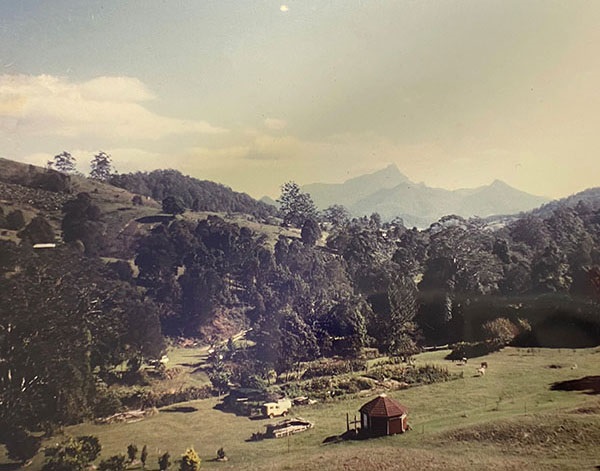 Mandala, 1974-1975, photograph by David Johnstone, Papers of David Johnstone, Australian Queer Archives.
Mandala, 1974-1975, photograph by David Johnstone, Papers of David Johnstone, Australian Queer Archives.Trail-blazing LGBTQIA+ womyn have chosen to settle in the small towns of the Northern Rivers since the early 1970s. Wanting to escape from discrimination and the pressures of urban life, they found that the Tweed offered them a place to connect feminist and environmentalist ideas. In return, the lesbians who arrived here not only built a life for themselves and created womyn-only spaces; they forged a local queer culture unique to the Tweed Shire.
Womyn at Mandala 1970s-1980s
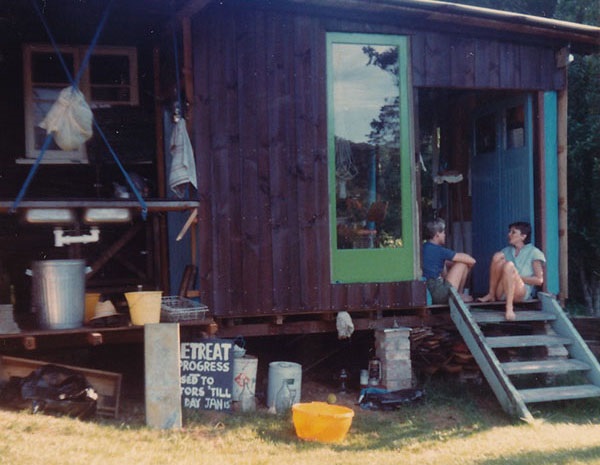 Wimmins Gathering, photographed by Vera Bourne, 1983. Papers of David Johnstone, Australian Queer Archives. Courtesy of Ian Gray.
Wimmins Gathering, photographed by Vera Bourne, 1983. Papers of David Johnstone, Australian Queer Archives. Courtesy of Ian Gray.Mandala is considered Australia’s first gay intentional community, established in 1973 and located near Wollumbin / Mount Warning. Set on a 230-acre property near Uki, the commune was created by local identity David Johnstone, who moved from Sydney in the early 1970s following the counter-culture festivals called Down to Earth. For almost thirty years, Mandala was an ecological oasis and rural retreat for gay men and womyn who visited from all over Australia.
David and his longtime lesbian friend, Vera Bourne, and her partner, Darlene Cook, organised a number of retreats for womyn and their children, including during the Summer Dreams camping holiday held in January 1983. For seven days, Mandala became the exclusive domain of lesbians – no men were allowed on the property. The program was advertised as an opportunity for “caring, sharing and growing, for wimmin to improve the way they relate to other gay wimmin and the world”.
Mandala was a “do it yourself”, communal experience and the womyn were encouraged to share their skills, and assist with meal preparation and chores. Womyn were also expected to commit to spending time together and participate in the communal experience.
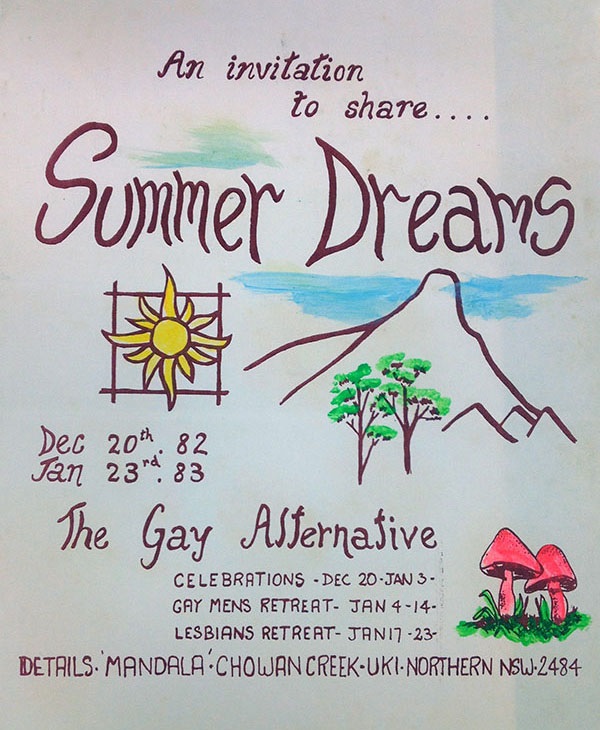 Summer Dreams poster, 1982-83, by David Johnstone. Papers of David Johnstone, Australian Queer Archives.
Summer Dreams poster, 1982-83, by David Johnstone. Papers of David Johnstone, Australian Queer Archives.With limited shelter at Mandala, the womyn and their families brought tents and gumboots. While the facilities were considered primitive, the property included a swimming hole, sauna, permaculture garden, bush walking trails and a special area set aside for time alone.
Informal workshops were held on alternative healing, photography, yoga and nutrition. Discussion groups aimed to work through difficulties and conflicts, so the womyn could grow together and learn from each other.
According to Darlene Cook, in the mid-1980s, “the men at Mandala vacated the property for a week…to allow the lesbian community to experience Mandala magic for a week. It was an amazing experience and I still feel thankful to David and all the ‘boys’ for allowing us to have that week of learning and trusting and community living”.
David sold Mandala in 2000, and eventually settled in Cambodia where he passed away in 2017. Read more about the history of Mandala.
A Slice of Heaven 1990-2000
Nestled amongst 12 acres of rainforest in the subtropical Tweed Valley, A Slice of Heaven has provided space for Womyn-only rural retreats since 1988.
When the owners went to inspect the Stokers Siding property in 1988, the song Slice of Heaven was playing on the car radio as they drove up the driveway; they said “they knew they were home”.
The new owners promptly set about creating a rural retreat for womyn using the principles of permaculture. As their three mischievous goats watched on, they planted over 4000 rainforest trees, native shrubs and a tropical orchard. A labour of love, the property was gradually transformed from an almost bare paddock into a Sapphic island of tranquillity where lesbians could meet other lesbians.
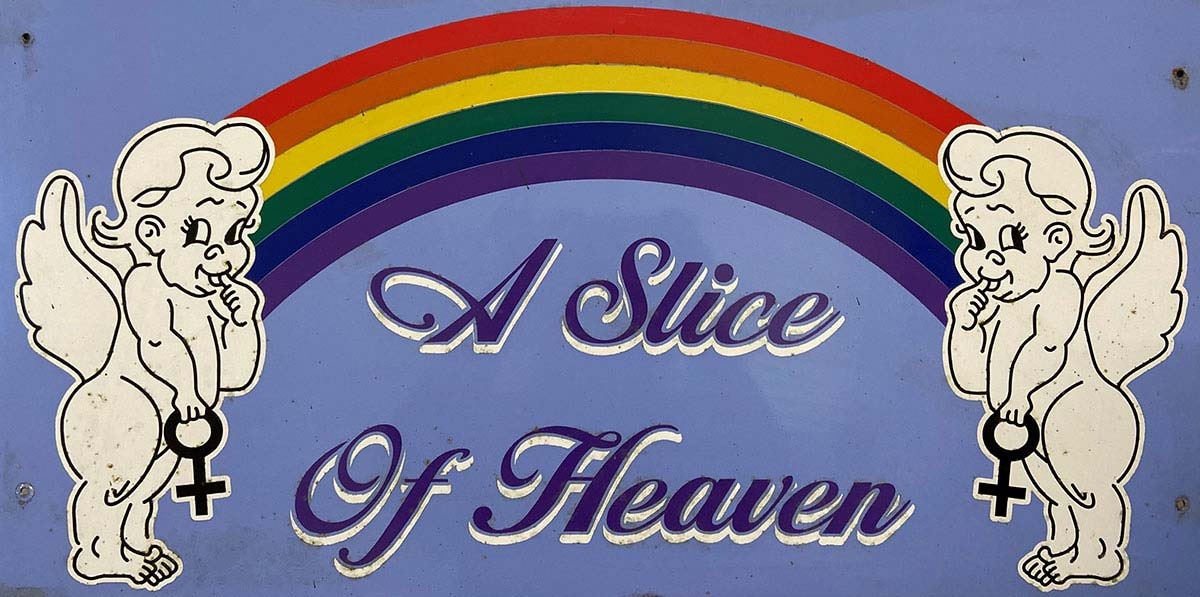
A Slice of Heaven sign.
A Slice of Heaven's owners prided themselves on treating guests as friends rather than visitors. At a time when it was not easy for women to share a hotel room without attracting suspicion and discrimination, many Australian lesbians were left isolated. A Slice of Heaven became a safe haven for womyn who identified as lesbians and for others who wished to explore their sexuality.
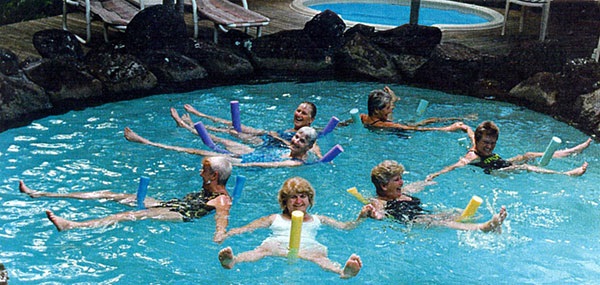 “Fun-shop” at A Slice of Heaven pool. Photo supplied by the Owners.
“Fun-shop” at A Slice of Heaven pool. Photo supplied by the Owners.Staying at the retreat, friendships and networks bloomed, and there was the potential to meet lovers and have fun. One feature was a super-sized luxurious bath, which held four women at a time "That's all it is: a bath, not a spa. Kinky, eh? In that wholesome, Northern Rivers kind of way", the owners explain (LOTL, 1995). After having enjoyed the company of local lesbians at a dinner party hosted by the owners, one guest proclaimed "Dykes know how to feed the sisterhood". The freedom to holiday together and the promise of privacy attracted many famous lesbian couples to stay.
In addition to running A Slice of Heaven, the owners created a network of older womyn called Growing Old Disgracefully. They hosted "fun-shops" for womyn to reawaken their wants and dreams, through conscience raising, collective art-making and on one occasion using their bodies to make music. They eventually published a book, Growing Old Disgracefully Down Under, which the Museum recently acquired for the collection. The hope for the book was that it would encourage other womyn to form their own groups and support networks. The book contains stories of courage and strength to inspire older women to take charge of their remaining years. They even made it into the local paper, when a feature story was run on the group.
In 2020, after three decades, the owners are moving on to the next adventure in their quest to grow old disgracefully. Their slice of heaven in the Tweed will be affectionately remembered as a place of sisterhood, pleasure and escape.
Feathers Women’s Social Club 1991-2017
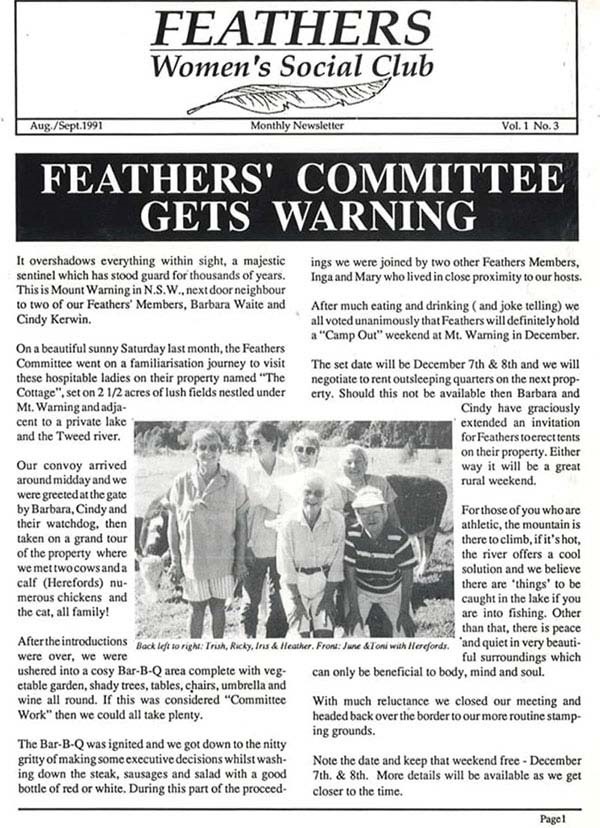 Feathers’ Newsletter, 1991. Courtesy of the Australian Queer Archives.
Feathers’ Newsletter, 1991. Courtesy of the Australian Queer Archives.Established in the early 1990s, Feathers Women's Social Club is the longest-running lesbian women's social club on the Gold Coast. The group formed after a small gathering of friends lamented the lack of local clubs for gay women. The deceased partner of founding member Iris Coulson, Heather (nicknamed Feathers), inspired the group's name.
For a quarter of a century, the not-for-profit club offered a safe, welcoming environment for lesbians, and was committed to supporting causes and enriching the lives of those within their diverse community. According to past Club president, Jan Curtis, "Feathers could be the most long-lived group of its kind in the world" (ABC, 2015).
The first Feathers dance event was a Suppa Dance in 1991 and the group continued to hold regular social events including dances, luncheons and many trips across the border to Tweed Shire. Early in the group's history, Feather's Committee visited the The Cottage, near Wollumbin / Mount Warning, owned by some Feathers members (see the newsletter on right). The group closed in 2017.
Van Dykes 2017 – present
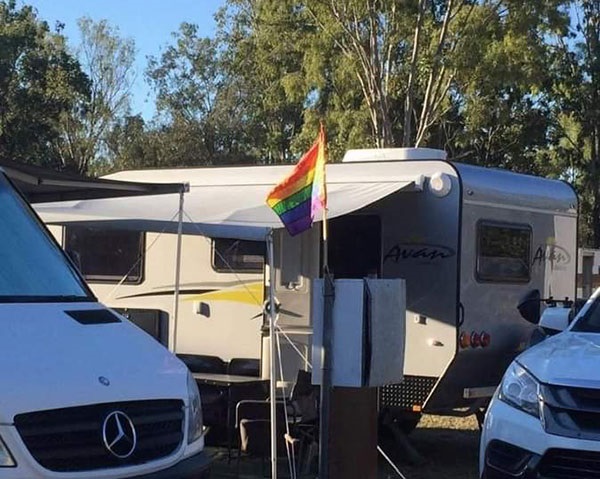 ”Tranquillity in Abundance”, Van Dykes’ camp at Dingo Queensland. 2020, Photographer: Alex Baker (Gay & Lesbian Tourism Australia).
”Tranquillity in Abundance”, Van Dykes’ camp at Dingo Queensland. 2020, Photographer: Alex Baker (Gay & Lesbian Tourism Australia).Van Dykes is an Australian group of lesbian campers and van owners, established by Pottsville local, Leonie Dickinson, in 2017 (not to be confused with the North American mid-1970s Van Dykes movement of lesbian van owners). Needing a holiday, and some like-minded travellers to go with, Leonie started the Facebook group appropriately named Van Dykes...and it went off like wildfire!
Primarily Van Dykes is a selective, special interest group for road-trippin’ Dykes, which has grown into a dynamic, nation-wide community of 2400 plus women of all sexualities and identities. Choosing their own adventure, from weekends away or hitting the road full-time, many of the women are digital storytellers sharing amazing images of regional Australia, as well as the occasional laugh and debate in a “lez be friendly” atmosphere.
“Lots of lesbians like to camp; it is as simple as that. The group is for anyone who identifies as a dyke and who likes the great outdoors, nature and travel. You don’t need a van, or a camper, you can have a tent or sleep in the back of your car”, Leonie says (OUTInPerth, 2018). Read more about Leonie Dickinson.

Van Dykes is about community, but it is not a separatist collective. In Van Dykes women freely exchange ideas and travel advice, including great places to visit that are LGBTQIA+ friendly, which is pretty vital for their safety.
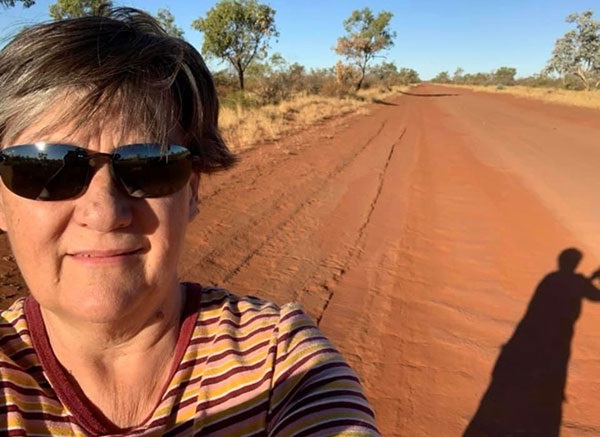 Leonie on the road in central Australia. Courtesy of Leonie Dickinson.
Leonie on the road in central Australia. Courtesy of Leonie Dickinson. Leonie’s camp set up at Corindi Beach. Courtesy of Leonie Dickinson.
Leonie’s camp set up at Corindi Beach. Courtesy of Leonie Dickinson.
The spirit behind a Van Dyke camp, according to Leonie, is self-organisation and inclusivity, and members look out for the women who are on their own. As one Van Dykes member explains, many camping or social groups are male-dominated. Leonie adds with a chuckle that there are “no dicks in Van Dykes”.